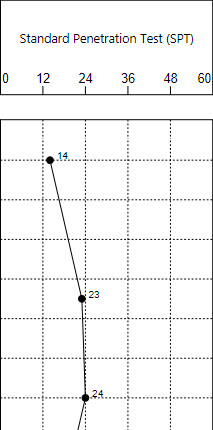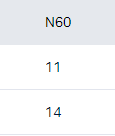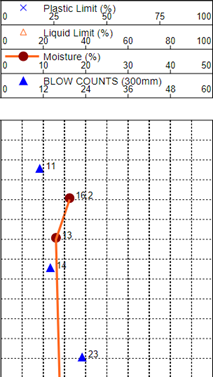Data Entry
On the Settings page → Data Entry tab, you can change the default settings that are automatically loaded on data entry pages (i.e., Projects, Test Holes, etc.).
To adjust the default Data Entry settings:
- Go to the left-hand navigation menu and select Settings,
- Click Data Entry tab,
- Make desired changes as necessary,
- Click Save (some tabs don't have a Save button as everything will be saved automatically).
These data entry settings include the following:
General tab
For New Projects
- Unit System: Determines the depth unit used in the program. Choose between Imperial (feet) and Metric (metres) unit systems.
- Coordinate Reference System: Used to specify the coordinate reference system for project and borehole locations. See this page for detailed discussion of options.
- Site UTM Zone: If UTM is used as the coordinate reference system for a project, the UTM zone needs to be specified. RSLog can automatically detect your UTM Zone based on your location (see Location Services page).
For New Test Holes
- Sample Type: Select the default Sample Type assigned to a new sample. List of Sample Types may be edited on Settings page > Field Investigation tab.
- Field Test Type: Select the default Field Test Type when adding field test data. List of Field Tests may be edited on Settings page > Field Investigation tab.
- Drill Method: Select the default Drill Method when a test hole is created. List of Boring Methods may be edited on Settings page > Field Investigation tab.
Test Hole Completion Notes
Completion Notes are displayed at the top and at the bottom of the Lithologic Description column in the borehole log. In this section of the Settings page you can set default texts for Completion Notes when creating a new test hole. User can utilize RSLog built-in keywords in these notes (see below).
- Start Notes: This is a note that will be presented at the top of the first layer in the Lithologic Description column of the borehole log (i.e. at depth = zero).
- Termination Notes: This is a note that will be presented at the bottom of the last layer in the Lithologic Description column of the borehole log.
Both Start Notes and Termination Notes can be overridden during borehole data entry from General tab > Completion Notes section (on the right side of the page).
- {name} will be replaced by test hole name (e.g. "BH-01").
- {depth} will be replaced by borehole depth, including the depth unit (e.g. "34.5 ft").
- {elevation} will be replaced by borehole collar elevation, including the unit (e.g. "652.8 ft").
- {water_depth} will be replaced by groundwater depth, including the depth unit (e.g. "7.8 m").
- {spt_energy} will be replaced by SPT hammer energy (e.g. "60 %").
Style of Tables
The majority of data entry in RSLog is carried out in tables. In this section of the Settings page user selects the style of tables in RSLog:
| Compact View | Spreadsheet View |
|---|---|
When this style is selected, only the key columns are shown. To edit the full data for a record, hover on that row and click the Edit button at the right end of the row; This opens a new dialog box where you can edit all input data.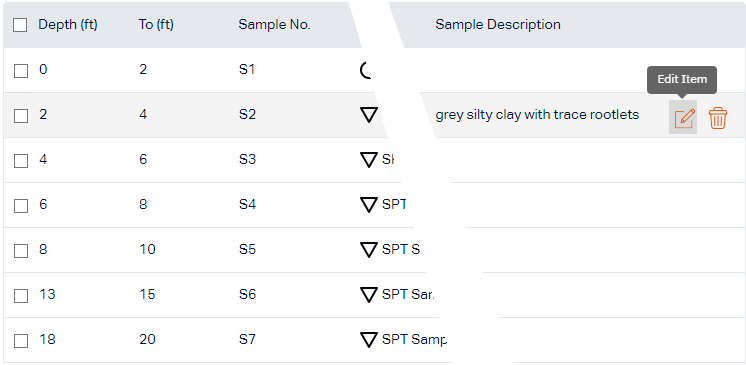 | This style resembles editing a spreadsheet. All columns are shown and user can navigate between cells using arrow keys. To edit a cell, press Enter or click on the cell. To finish editing, press Enter again.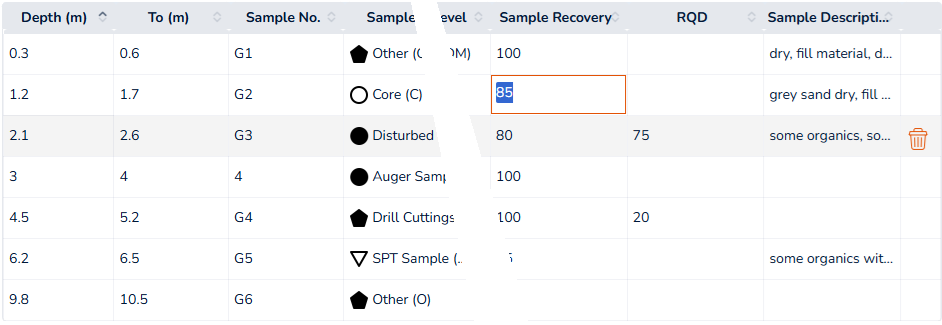 |
Stratigraphy Customizations
In this section you can set the default line style used for new stratigraphy records.
The 'Enforce detailed stratigraphy data entry' checkbox is used for enforcing a company-wide Detailed view data entry for stratigraphy. This options guarantees consistency (no typo, same order of elements, same elements) of the lithology description generated by all RSLog users in your company.
Sample Data (demo)
Using this feature you can import demo projects and demo borehole log templates to your RSLog account. Use this if you accidentally deleted the demo projects and templates from your account.
User-Interface Language
To change the language of RSLog user-interface, please go to Settings page → Data Entry tab → Language section.
SPT Rules tab
Use this section of the Settings page to specify how refusals or other special cases should be handled when calculating N-Value and N60 blow counts. RSLog follows ASTM D1586 for calculating Standard Penetration Test blow count N-Value.
The value of N60 is calculated automatically based on SPT Hammer Energy Level entered on the General tab → SPT Hammer and Sampler section.
- If the blow count data starts with the word "REF" e.g. REF 35/3", this blow count will be considered as refusal. In this case, the SPT / DCPT graph in the borehole log uses a blow count of 50 to show this data on the graph. The keyword "REF" and the refusal number for the graph (i.e. 50) can be set in the SPT Rules tab.
- For cases where the SPT sampler is driven into the soil with no effort (i.e. under the self weight of the hammer or rod), user can enter "WH" or "WR" as the test result. In this case, the SPT / DCPT graph in the borehole log users a blow count of zero to show this data on the graph. The keywords "WH" and "WR" can be set in the SPT Rules tab.
SPT Blow Counts on the Log
SPT blow counts may be shown in the borehole log in different formats. The following table summarizes these options:
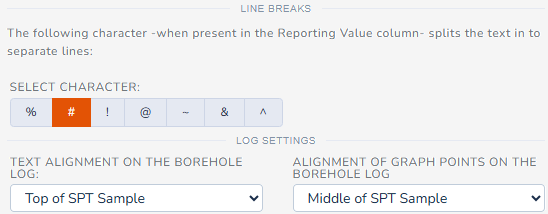
Use the Text Alignment dropdown to determine whether the SPT blow counts should be aligned to the top of sample, middle of sample, or bottom of sample.
Use the Alignment of Graph Points dropdown to determine positioning (top, middle or bottom of SPT sample) of the data points on a SPT graph.
Appearance on the Log | Log Template Design | Data Entry Method |
|---|---|---|
 | Add a Text/Number » Field Test Results log column and link it to the Reporting Value of your SPT test. | Use Reporting Value column as shown below. This column allows alphanumeric values (e.g. use of comma etc.)
 |
| Add a Text/Number » Field Test Results log column and link it to a Concatenated Column that is formatted based on your SPT data.
The concatenation format may include field test columns combined with additional characters. See 3 examples on the left. | On Settings page create a 'Concatenated Column' for your SPT test. This column will be automatically formatted based on other SPT columns.

|
 | Add a Text/Number » Field Test Results log column and link it to the Reporting Value of your SPT test. | Use Reporting Value column as shown below. Use the Split Character between the numbers to force the data to show in multiple rows in the log.
 |
|
| Add 3 separate Text/Number » Field Test Results log columns and link them to corresponding columns of your SPT test. | Enter data in separate columns. You can customize the columns of your field tests to accept data in multiple columns.
|
The SPT blow counts displayed on the borehole log can align to the top, middle or bottom of the SPT test. This can be set using the dropdown under the Split Character section on this page.
SPT Graph on the Log
SPT blow counts may be shown in the borehole log in different ways depending on the details. The following table summarizes these options:
Appearance on the Log | Log Template Design | Data Entry Method |
A graph showing SPT blow counts only
| Add a Graphic » Field Test Results log column and link it to the desired data column (e.g. N60) in your SPT field test. | Enter blow count details in separate columns. You can customize the columns of your field tests to accept data in multiple columns.
|
A graph showing SPT blow counts along with other field / lab tests
| Add a Graphic » Graph (customizable) log column and add different data series linked to the desired data sources (e.g. various field / lab tests). | Enter blow count details in separate columns. You can customize the columns of your field tests to accept data in multiple columns.
|
Extra Tags tab
You can expand the list of data that you enter for a project and a test hole by using Extra Tags. An example of Extra Tag is the Contract Number for a project; since Contract Number is not a default data entry item in RSLog, you can add it from the Settings page → Data Entry tab → Extra Tags tab. For each Extra Tag determine the following data:
- Tag Name: this is the label of the Extra Tag shown on RSLog user interface (e.g. during data entry on project page).
- Data Type: determines the type of data expected for this Extra Tag. Options are Number, String (text), Boolean (checkbox true / false), and Pick List (dropdown list).
- Value: only applies to a Pick List tag. For a Pick List, enter the dropdown options in comma separated format. For example if you add an Extra Tag for Department and would like the user to choose from Civil, Geotechnical and Environmental, in Value field write Civil, Geotechnical, Environmental.
- Description: will be shown as the tooltip of the Extra Tag on the data entry page.
Data Entry for Project Extra Tags
- On project data entry page, click Extra Tags tab to see the list of Extra Tags (more details),
- Click the cell in front of the desired item to enter data.
Data Entry for Borehole Extra Tags
- On borehole data entry page → General tab, open the Extra Tags section on the right side of the page to see the list of Extra Tags (more details),
- Click the cell in front of the desired item to enter data.
Presenting Extra Tags on the Borehole Logs
- Edit the desired log template from the Report Templates page,
- Click Customize Layout button to open the header/footer designer,
- Add or select a Database Field element, and from its property grid (left side of screen) find the Source property and click Open Menu button,
- Choose whether you would like to link this label to a Project or a Borehole,
- In the list of source items, scroll down to the bottom of the list to see the Extra Tags section,
- Select the desired Extra Tag and click Apply button,
- Save the header/footer designer.
Progress Status tab
In RSLog, projects and test holes can be set a 'Status'; This allows determining at what stage the project or the test hole is by changing the status as the project advances to the next phase, or as the subsurface investigation of the test hole advances.
Project Progress Status
Use the table to edit the list of project statuses. The following statuses cannot be altered:
- Active (site investigation): is used to show that the project is in site investigation phase,
- Archived: a project with Archived status will not be shown in the list of current projects. You can see the Archived projects by going to the Archived tab on Projects page.
Test Hole Progress Status
Use the table to edit the list of test hole statuses. The default options in this list are meant to represent the natural flow of drilling a borehole/excavating a test pit. The status of test holes is used to show the investigation progress visually at the top of the Test Holes page:

The following statuses are pre-built and cannot be deleted, however user can change the color and indicator (%) associated with any status:
- Planned: refers to a test hole that is created by RSLog Pre-Investigation Planner feature. A Planned test hole is 'planned' to be drilled/excavated but its investigation has not started yet.
- Utility Locating: indicates that utility locating is in progress for this test hole,
- Drilling / Excavating: means the test hole is in drilling or excavating state,
- Backfilling: indicates that the drilling of excavating phase is over and the test hole is being decommissioned,
- Completed: indicates that the field investigation for this test hole is completed. The default color of this test hole status may be changed by editing this record,
- Abandoned: test hole had to be abandoned (typically due to access issues, utility conflicts or subsurface challenges),
- Canceled: The field investigation for this test hole has been canceled.
Quality Management tab
This tab allows for customization of the quality management roles (defined at the project level and assigned to each test hole) and quality management status (associated to test holes). For further information please see Quality Management documentation.



